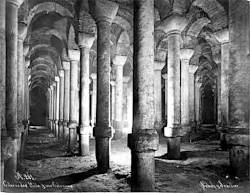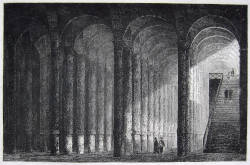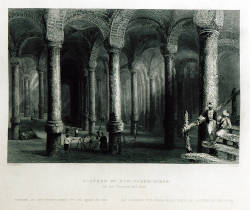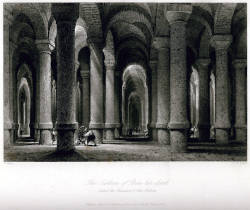Binbirdirek Sarnıçı
Κινστέρνα Φιλοξένου - Binbirdirek Cistern - Cistern of Philoxenos
Useful Information


| Location: |
İmran Öktem Sokak 4, Fatih district, Istanbul.
(41.00757475139001, 28.97432953119278) |
| Open: |
All year Tue-Sun 9-20. [2020] |
| Fee: |
Adults TRL 10, Foreigners TRL 20. [2020] |
| Classification: |
 Cistern Cistern
|
| Light: |
 Incandescent Incandescent
|
| Dimension: | L=64 m, W=56 m. Ar=3,640 m², V=40,000 m³ |
| Guided tours: | |
| Photography: | |
| Accessibility: | |
| Bibliography: | |
| Address: | Binbirdirek Sarnıçı, Binbirdirek Mah, İmran Öktem Cd. No:2/1, 34122 Fatih/İstanbul, Tel: +90-542-450-1001. |
| As far as we know this information was accurate when it was published (see years in brackets), but may have changed since then. Please check rates and details directly with the companies in question if you need more recent info. |
|
History
| 4th or 5th century | cistern built. |
| 475 | Palace of Antiochos completely destroyed. |
| 6th century | cistern restored by Justinian I. |
| 1453 | city conquered by the Ottomans, the cistern fell into disuse and was forgotten. |
| 17th century | rediscovered during the construction of Fazli Pasha’s palace. |
Description


Binbirdirek Sarnıçı (Cistern of 1001 Pillars) is the second largest cistern of Istanbul. It was built during the 5th century under the Palace of Antiochos. Palace and cistern were built by Philoxenus and the cistern is thus often called Cistern of Philoxenos. Philoxenus was one of the Roman senators who moved to the city after it became the capital of the Roman Empire. The palace was completely destroyed in a fire in 475. In the 6th century the cistern was restored by Justinian I and it was again used as a cistern. In 1453 the city was conquered by the Ottomans, the cistern fell into disuse and was forgotten. It was rediscovered in the 16th century during the construction of Fazlı Pasha’s palace. The German traveler R. Lubenau reports that the cistern was used as a silk processing workshop.
There is a legend or fairy tale about the cistern. It happened during the reign of Murat, Fazlı Pasha’s elderly daughter. Her young and beautiful concubine Gevherli Hanım lured wealthy people to her palace. Murat imprisoned them in the cistern, then killed them and confiscated their wealth.
The cistern is a huge rectangular chamber, 64 m long and 56 m wide, with 224 columns which support the brick vaults. They are set in 16 rows of 14 columns 3.75 m apart from each other. The columns are 14 m to 15 m tall and are made of marble from nearby Marmara Island. The columns consist of two parts connected by a marble ring. The floor of the cistern was reinforced during one of the renovations and today only a short sleeve of the lower column is visible. In the center is an excavated pond with four columns where the original height can be seen. The columns and the capstones are engraved with a Greek mason’s mark.
Today the cistern ist mostly known as Binbirdirek Cistern. Binbirdirek is a Turkish word which means literally 1001 columns. But Binbir is often used to express something that is numerous and varied. Obviously this is also the case in the name, it should be translated lots of columns. The name is first mentioned in the Ottoman period.
- See also
 Search DuckDuckGo for "Binbirdirek Sarnıçı"
Search DuckDuckGo for "Binbirdirek Sarnıçı" Google Earth Placemark
Google Earth Placemark Cistern of Philoxenos - Wikipedia (visited: 22-OCT-2020)
Cistern of Philoxenos - Wikipedia (visited: 22-OCT-2020) Cistern of Philoxenos - The Byzantine Legacy (visited: 23-MAR-2021)
Cistern of Philoxenos - The Byzantine Legacy (visited: 23-MAR-2021) Binbirdirek Sarnıçı
Binbirdirek Sarnıçı  (visited: 22-OCT-2020)
(visited: 22-OCT-2020) Binbirdirek Sarnıçı – Fatih / İstanbul
Binbirdirek Sarnıçı – Fatih / İstanbul  (visited: 22-OCT-2020)
(visited: 22-OCT-2020)
 Index
Index Topics
Topics Hierarchical
Hierarchical Countries
Countries Maps
Maps